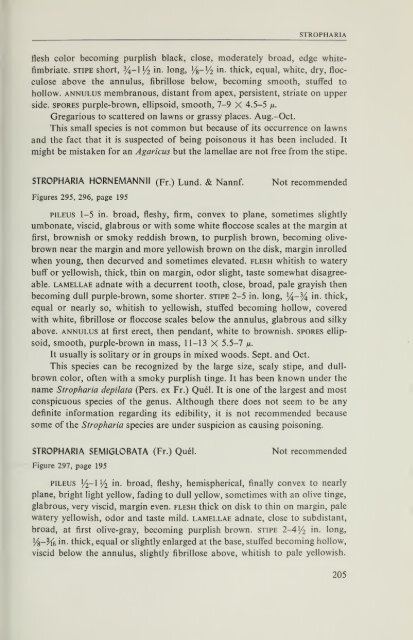Create successful ePaper yourself
Turn your PDF publications into a flip-book with our unique Google optimized e-Paper software.
STROPHARIA<br />
flesh color becoming purplish black, close, moderately broad, edge white-<br />
fimbriate. stipe short, 3/^-1 V2 in. long, Ys-Vi in. thick, equal, white, dry, floc-<br />
culose above the annulus, fibrillose below, becoming smooth, stuffed to<br />
hollow. ANNULUS membrauous, distant from apex, persistent, striate on upper<br />
side. SPORES purple-brown, elHpsoid, smooth, 7-9 X 4.5-5 /x.<br />
Gregarious to scattered on lawns or grassy places. Aug.-Oct.<br />
This small species is not common but because of its occurrence on lawns<br />
and the fact that it is suspected of being poisonous it has been included. It<br />
might be mistaken for an Agaricus but the lamellae are not free from the stipe.<br />
STROPHARIA HORNEMANNII (Fr.) Lund. & Nannf. Not recommended<br />
Figures 295, 296, page 195<br />
piLEUS 1-5 in. broad, fleshy, firm, convex to plane, sometimes sHghtly<br />
umbonate, viscid, glabrous or with some white floccose scales at the margin at<br />
first, brownish or smoky reddish brown, to purplish brown, becoming ohve-<br />
brown near the margin and more yellowish brown on the disk, margin inrolled<br />
when young, then decurved and sometimes elevated, flesh whitish to watery<br />
buff" or yellowish, thick, thin on margin, odor sHght, taste somewhat disagree-<br />
able. LAMELLAE adnatc with a decurrent tooth, close, broad, pale grayish then<br />
becoming dull purple-brown, some shorter, stipe 2-5 in. long, i4-% in. thick,<br />
equal or nearly so, whitish to yellowish, stuff'ed becoming hollow, covered<br />
with white, fibrillose or floccose scales below the annulus, glabrous and silky<br />
above, annulus at first erect, then pendant, white to brownish, spores elHp-<br />
soid, smooth, purple-brown in mass, 11-13 X 5.5-7 ju-<br />
It usually is soHtary or in groups in mixed woods. Sept. and Oct.<br />
This species can be recognized by the large size, scaly stipe, and dull-<br />
brown color, often with a smoky purpHsh tinge. It has been known under the<br />
name Stropharia depilata (Pers. ex Fr.) Quel. It is one of the largest and most<br />
conspicuous species of the genus. Although there does not seem to be any<br />
definite information regarding its edibility, it is not recommended because<br />
some of the Stropharia species are under suspicion as causing poisoning.<br />
STROPHARIA SEMIGLOBATA (Fr.) Quel. Not recommended<br />
Figure 297, page 195<br />
PILEUS I/2-I Yi in. broad, fleshy, hemispherical, finally convex to nearly<br />
plane, bright fight yellow, fading to dull yellow, sometimes with an oHve tinge,<br />
glabrous, very viscid, margin even, flesh thick on disk to thin on margin, pale<br />
watery yellowish, odor and taste mild, lamellae adnate, close to subdistant,<br />
broad, at first ohve-gray, becoming purplish brown, stipe 2-4)/^ in. long,<br />
V%-H%<br />
in. thick, equal or sHghtly enlarged at the base, stuff'ed becoming hollow,<br />
viscid below the annulus, slightly fibrillose above, whitish to pale yellowish.<br />
205

















